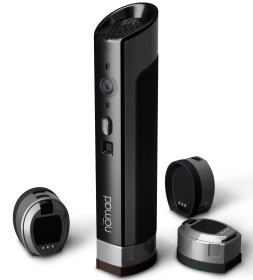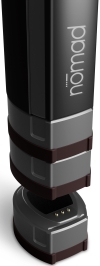

Now that Covid restrictions are being lifted and travel is once again allowed, many people will be getting on the road for business or personal reasons. Security in Motion, a company based in the USA, recently unveiled Nomad, an integrated security system that goes wherever you go, offering LTE connectivity to your mobile device along with HD video, motion detection and other sensors that can be added as ‘pods’ that are monitored by the base.
Now that Covid restrictions are being lifted and travel is once again allowed, many people will be getting on the road for business or personal reasons. Security in Motion, a company based in the USA, recently unveiled Nomad, an integrated security system that goes wherever you go, offering LTE connectivity to your mobile device along with HD video, motion detection and other sensors that can be added as ‘pods’ that are monitored by the base.
Other pods include vibration, smoke or light sensors. In fact, Gregg Bieser, inventor of Nomad says almost any type of IoT sensor can be made into a pod. All the pods attach securely to the base station when not in use, ensuring they don’t get lost and are activated automatically when detached (this is the default which users can change).
Other pods in the R&D; phase include thermal video cameras, fire detection, liquid detection and more. The company is even experimenting with sending signals underwater so that those on a diving holiday can be warned of any suspicious motion while they are under water (this is not available but sounds like an amazing idea).
The base system, which includes the HD camera with a motion sensor, connectivity, speaker (for audio and alarms) and LED light, allows setup via a touch sensitive pad or via the Nomad app and measures less than 15nbsp;cm in length. With three pods attached, the Nomad is about 22 cm long. The base communicates directly with your mobile device to alert you every time a sensor is triggered and it communicates with the pods for alarm information via Bluetooth, as well as to check their functionality and battery status.
The touchpad can be used to set up the Nomad, guided by voice prompts, while the app can also be used for the same thing. Alarms can be raised via the speaker and sent directly to the user’s smartphone.
Once the user has downloaded the app to their smartphone, they will receive notifications when the Nomad is armed and connected as well as alarm activation alerts in real-time. They can then decide to view a live or recorded video stream to determine what is going on and decide what action to take (an SD card on the base stores video locally and cloud options may also be used). A live video stream can also be viewed on the mobile device whenever the user chooses. Multiple mobiles can receive alarms and video, so it is not restricted to a single device.
Nomad runs off battery power and the base station will provide about two days of functionality and can be recharged from virtually any cellphone charger with an USB-C connector. Each pod also includes its own battery, the duration of which is from one day upwards depending on the sensor being used. Naturally, the more alerts and signals detected the more the battery will be used.
In South Africa and Africa, it will also make for a good home security system that does not rely on a stable power supply or expensive fibre connections to control rooms. Bieser mentions that a Bluetooth extender pod is another potential pod to extend users’ monitoring distance.

Use cases for Nomad
The Nomad was designed for travellers. Some uses include keeping a video-enabled eye on your hotel or BnB room, using a vibration sensor on the door or window while sleeping, or keeping the light sensor in a safe to warn you if someone opens the safe while you are away. If you’re worried about leaving a bag behind (or someone walking off with it) while at the airport, the system could warn you that it is out of range.
The system can also be used to create a virtual perimeter around a camping site using motion detection pods, as well as fire detection to ensure the campfire behaves itself. Users can even leave the system in their cars and receive alerts if someone breaks in or bumps the car.
In a professional environment, police or military teams can use the Nomad when entering an unknown building or environment, setting the base station up as a rear guard will alert the team if someone is trying to sneak up behind them. The experimental thermal camera can be used in open areas to similarly warn of motion without having to leave personnel behind to keep watch. (These are naturally meant for temporary use and not as a permanent fixture.)
Go to market and launch
The Nomad team is putting the finishing touches to the product at the moment and is looking at launching it later this year (although with the current supply chain fiasco this might change). There are various go-to-market options being considered since the device is so versatile.
The Nomad itself can be sold as a unit without any connectivity options. In addition, the pods that come with the base unit can be included in the price or users can buy as many as needed for their requirements.
An alternative would be to sell the units with a cellular data contract (in a similar way many cell phones are sold today), where the user gets the device and pays a monthly fee which can include cloud storage of video and data. Or the system could be sold as a unit with a monthly subscription fee for the connectivity and the cloud storage. Bieser says the company is open to options and willing to hear from companies that can add value to the device.
Customisation potential
As noted above, almost any sensor can be made into a pod and the company is open to suggestions for customisation requests, for example a Bluetooth sniffer for sensitive meetings, temperature change pod or even gunshot detection. There is also the potential for an extended battery for the base system, if required.
The base is stable and therefore affords third parties a good foundation to create add-ons in terms of pods or associated services. Bieser notes that partnerships are welcome in bringing the system to the broadest market possible, whether these include technical ideas or connectivity and cloud services.
For a full breakdown of Nomad and a video of the product in action go to www.getnomad.net, or contact [email protected]

© Technews Publishing (Pty) Ltd. | All Rights Reserved.